Analysis of Culture, Motivation, and Power at British Petroleum
VerifiedAdded on 2020/11/30
|17
|5186
|92
Report
AI Summary
This report provides an in-depth analysis of the organizational behaviour of British Petroleum (BP). It begins with an overview of BP, detailing its operations and workforce size, followed by an examination of its culture, political influences, power dynamics, and motivational strategies. The report delves into behavioural motivation theories, including drive, learning approaches, and incentive motivation, and assesses their application within BP. It then explores various organizational cultures such as clan, adhocracy, market, and hierarchy cultures, and how Herzberg's two-factor theory is implemented within BP. The report also evaluates the impact of these theories on employee behaviour and concludes with a summary of the key findings. The report includes references to support the analysis of organizational behaviour within BP.
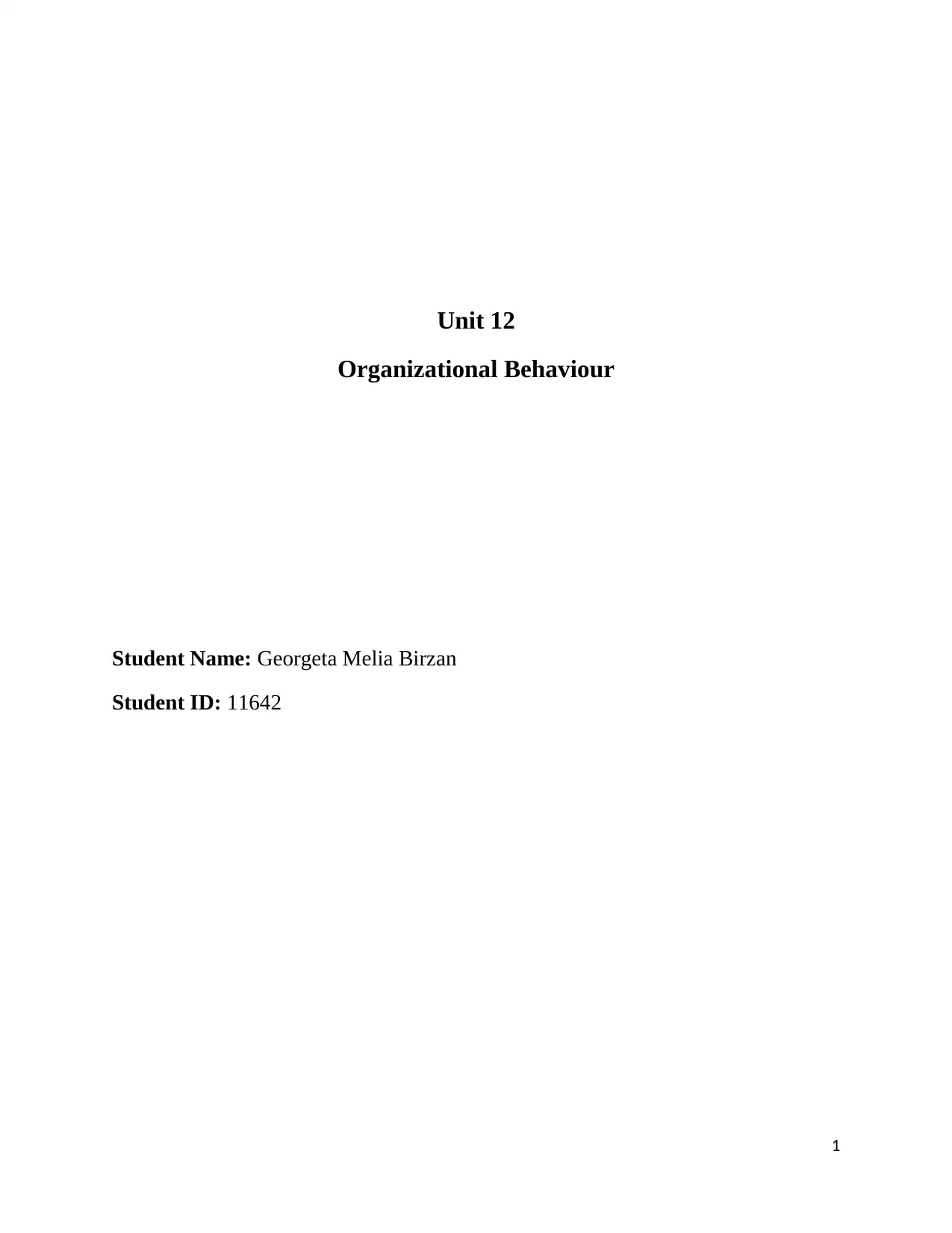
Unit 12
Organizational Behaviour
Student Name: Georgeta Melia Birzan
Student ID: 11642
1
Organizational Behaviour
Student Name: Georgeta Melia Birzan
Student ID: 11642
1
Paraphrase This Document
Need a fresh take? Get an instant paraphrase of this document with our AI Paraphraser
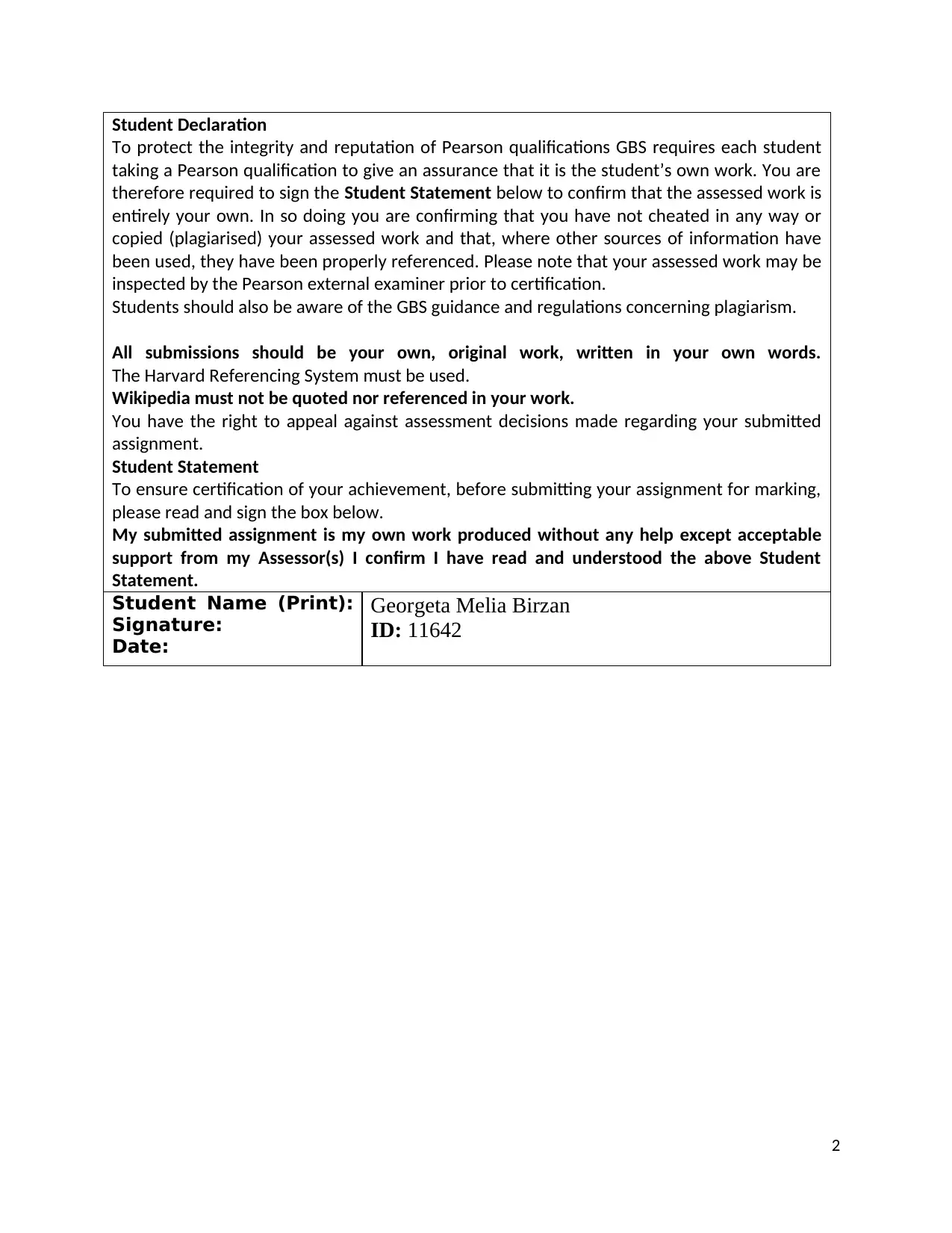
Student Declaration
To protect the integrity and reputation of Pearson qualifications GBS requires each student
taking a Pearson qualification to give an assurance that it is the student’s own work. You are
therefore required to sign the Student Statement below to confirm that the assessed work is
entirely your own. In so doing you are confirming that you have not cheated in any way or
copied (plagiarised) your assessed work and that, where other sources of information have
been used, they have been properly referenced. Please note that your assessed work may be
inspected by the Pearson external examiner prior to certification.
Students should also be aware of the GBS guidance and regulations concerning plagiarism.
All submissions should be your own, original work, written in your own words.
The Harvard Referencing System must be used.
Wikipedia must not be quoted nor referenced in your work.
You have the right to appeal against assessment decisions made regarding your submitted
assignment.
Student Statement
To ensure certification of your achievement, before submitting your assignment for marking,
please read and sign the box below.
My submitted assignment is my own work produced without any help except acceptable
support from my Assessor(s) I confirm I have read and understood the above Student
Statement.
Student Name (Print):
Signature:
Date:
Georgeta Melia Birzan
ID: 11642
2
To protect the integrity and reputation of Pearson qualifications GBS requires each student
taking a Pearson qualification to give an assurance that it is the student’s own work. You are
therefore required to sign the Student Statement below to confirm that the assessed work is
entirely your own. In so doing you are confirming that you have not cheated in any way or
copied (plagiarised) your assessed work and that, where other sources of information have
been used, they have been properly referenced. Please note that your assessed work may be
inspected by the Pearson external examiner prior to certification.
Students should also be aware of the GBS guidance and regulations concerning plagiarism.
All submissions should be your own, original work, written in your own words.
The Harvard Referencing System must be used.
Wikipedia must not be quoted nor referenced in your work.
You have the right to appeal against assessment decisions made regarding your submitted
assignment.
Student Statement
To ensure certification of your achievement, before submitting your assignment for marking,
please read and sign the box below.
My submitted assignment is my own work produced without any help except acceptable
support from my Assessor(s) I confirm I have read and understood the above Student
Statement.
Student Name (Print):
Signature:
Date:
Georgeta Melia Birzan
ID: 11642
2

Table of Contents
Section A.........................................................................................................................................4
Introduction..................................................................................................................................4
Overview of British Petroleum....................................................................................................4
Culture, politics, power, and motivation of British Petroleum....................................................4
Behavioural motivation theories and techniques.........................................................................5
Various organizational cultures and adopted motivational theories of BP..................................6
Impacts of mentioned theories in behaviours of BP....................................................................7
Conclusion...................................................................................................................................8
Section B..........................................................................................................................................9
Introduction..................................................................................................................................9
1.1 Benefits of working in a team................................................................................................9
1.2 A mix of knowledge, skills, and experience necessity to fill the functions of the
organization..................................................................................................................................9
1.3 Some reasons for an ineffective team set up........................................................................10
2. Team and group development theories of BP, and Evaluation of developing team..............10
3. Application and Evaluation of Organization Behaviour inform and influence behaviour in
terms of BP.................................................................................................................................12
4. Performance analysis of BP...................................................................................................14
Conclusion.................................................................................................................................15
Reference.......................................................................................................................................16
3
Section A.........................................................................................................................................4
Introduction..................................................................................................................................4
Overview of British Petroleum....................................................................................................4
Culture, politics, power, and motivation of British Petroleum....................................................4
Behavioural motivation theories and techniques.........................................................................5
Various organizational cultures and adopted motivational theories of BP..................................6
Impacts of mentioned theories in behaviours of BP....................................................................7
Conclusion...................................................................................................................................8
Section B..........................................................................................................................................9
Introduction..................................................................................................................................9
1.1 Benefits of working in a team................................................................................................9
1.2 A mix of knowledge, skills, and experience necessity to fill the functions of the
organization..................................................................................................................................9
1.3 Some reasons for an ineffective team set up........................................................................10
2. Team and group development theories of BP, and Evaluation of developing team..............10
3. Application and Evaluation of Organization Behaviour inform and influence behaviour in
terms of BP.................................................................................................................................12
4. Performance analysis of BP...................................................................................................14
Conclusion.................................................................................................................................15
Reference.......................................................................................................................................16
3
⊘ This is a preview!⊘
Do you want full access?
Subscribe today to unlock all pages.

Trusted by 1+ million students worldwide
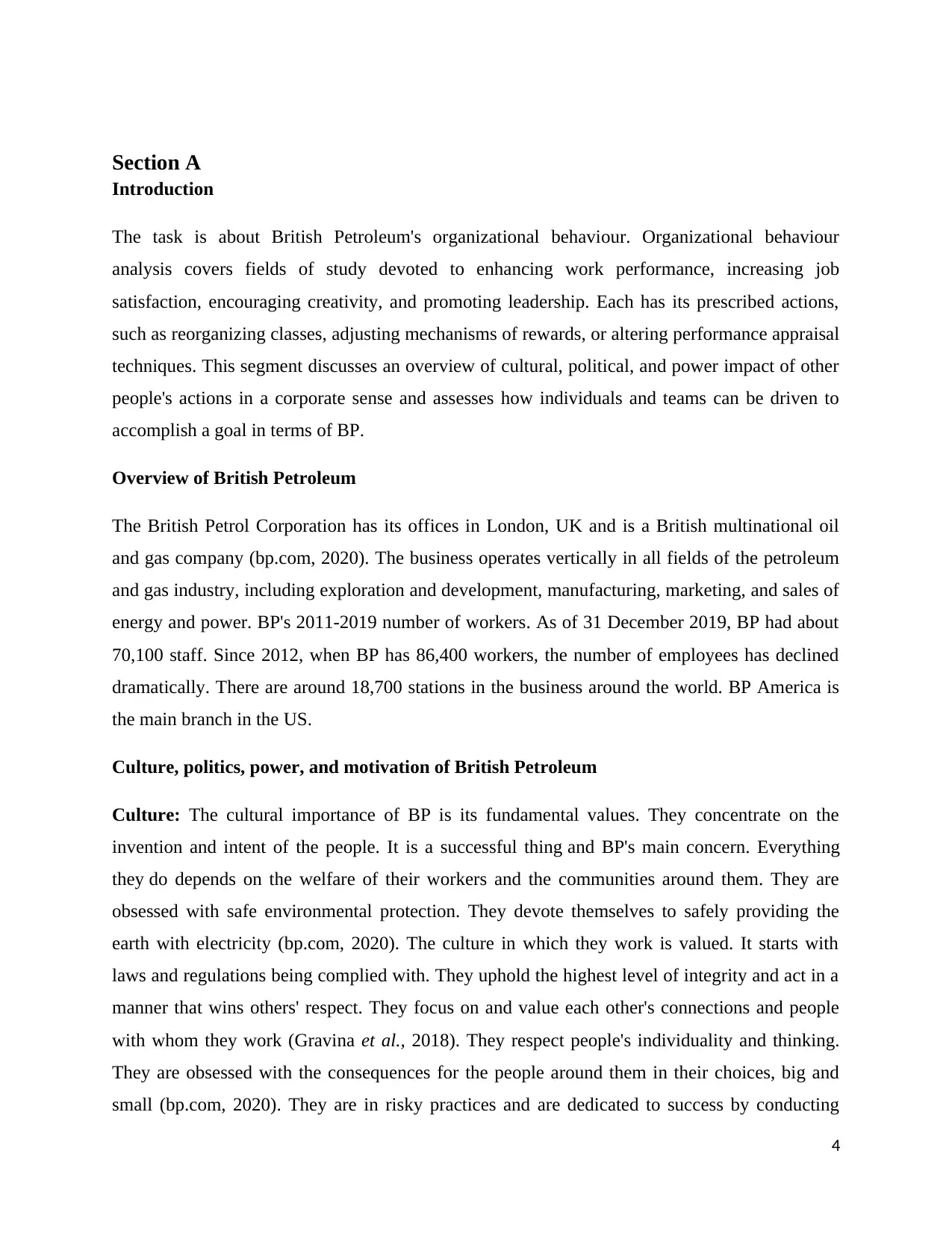
Section A
Introduction
The task is about British Petroleum's organizational behaviour. Organizational behaviour
analysis covers fields of study devoted to enhancing work performance, increasing job
satisfaction, encouraging creativity, and promoting leadership. Each has its prescribed actions,
such as reorganizing classes, adjusting mechanisms of rewards, or altering performance appraisal
techniques. This segment discusses an overview of cultural, political, and power impact of other
people's actions in a corporate sense and assesses how individuals and teams can be driven to
accomplish a goal in terms of BP.
Overview of British Petroleum
The British Petrol Corporation has its offices in London, UK and is a British multinational oil
and gas company (bp.com, 2020). The business operates vertically in all fields of the petroleum
and gas industry, including exploration and development, manufacturing, marketing, and sales of
energy and power. BP's 2011-2019 number of workers. As of 31 December 2019, BP had about
70,100 staff. Since 2012, when BP has 86,400 workers, the number of employees has declined
dramatically. There are around 18,700 stations in the business around the world. BP America is
the main branch in the US.
Culture, politics, power, and motivation of British Petroleum
Culture: The cultural importance of BP is its fundamental values. They concentrate on the
invention and intent of the people. It is a successful thing and BP's main concern. Everything
they do depends on the welfare of their workers and the communities around them. They are
obsessed with safe environmental protection. They devote themselves to safely providing the
earth with electricity (bp.com, 2020). The culture in which they work is valued. It starts with
laws and regulations being complied with. They uphold the highest level of integrity and act in a
manner that wins others' respect. They focus on and value each other's connections and people
with whom they work (Gravina et al., 2018). They respect people's individuality and thinking.
They are obsessed with the consequences for the people around them in their choices, big and
small (bp.com, 2020). They are in risky practices and are dedicated to success by conducting
4
Introduction
The task is about British Petroleum's organizational behaviour. Organizational behaviour
analysis covers fields of study devoted to enhancing work performance, increasing job
satisfaction, encouraging creativity, and promoting leadership. Each has its prescribed actions,
such as reorganizing classes, adjusting mechanisms of rewards, or altering performance appraisal
techniques. This segment discusses an overview of cultural, political, and power impact of other
people's actions in a corporate sense and assesses how individuals and teams can be driven to
accomplish a goal in terms of BP.
Overview of British Petroleum
The British Petrol Corporation has its offices in London, UK and is a British multinational oil
and gas company (bp.com, 2020). The business operates vertically in all fields of the petroleum
and gas industry, including exploration and development, manufacturing, marketing, and sales of
energy and power. BP's 2011-2019 number of workers. As of 31 December 2019, BP had about
70,100 staff. Since 2012, when BP has 86,400 workers, the number of employees has declined
dramatically. There are around 18,700 stations in the business around the world. BP America is
the main branch in the US.
Culture, politics, power, and motivation of British Petroleum
Culture: The cultural importance of BP is its fundamental values. They concentrate on the
invention and intent of the people. It is a successful thing and BP's main concern. Everything
they do depends on the welfare of their workers and the communities around them. They are
obsessed with safe environmental protection. They devote themselves to safely providing the
earth with electricity (bp.com, 2020). The culture in which they work is valued. It starts with
laws and regulations being complied with. They uphold the highest level of integrity and act in a
manner that wins others' respect. They focus on and value each other's connections and people
with whom they work (Gravina et al., 2018). They respect people's individuality and thinking.
They are obsessed with the consequences for the people around them in their choices, big and
small (bp.com, 2020). They are in risky practices and are dedicated to success by conducting
4
Paraphrase This Document
Need a fresh take? Get an instant paraphrase of this document with our AI Paraphraser
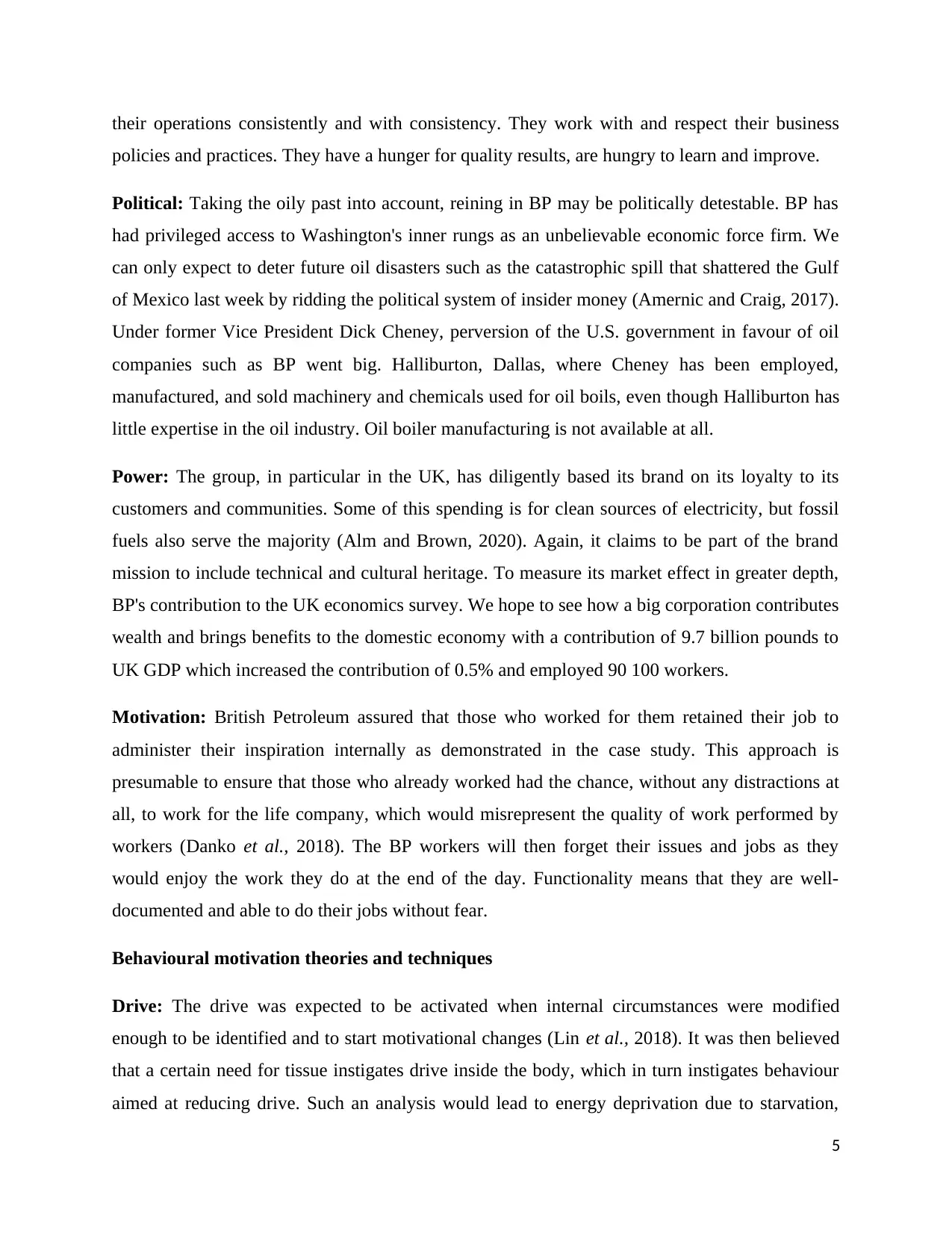
their operations consistently and with consistency. They work with and respect their business
policies and practices. They have a hunger for quality results, are hungry to learn and improve.
Political: Taking the oily past into account, reining in BP may be politically detestable. BP has
had privileged access to Washington's inner rungs as an unbelievable economic force firm. We
can only expect to deter future oil disasters such as the catastrophic spill that shattered the Gulf
of Mexico last week by ridding the political system of insider money (Amernic and Craig, 2017).
Under former Vice President Dick Cheney, perversion of the U.S. government in favour of oil
companies such as BP went big. Halliburton, Dallas, where Cheney has been employed,
manufactured, and sold machinery and chemicals used for oil boils, even though Halliburton has
little expertise in the oil industry. Oil boiler manufacturing is not available at all.
Power: The group, in particular in the UK, has diligently based its brand on its loyalty to its
customers and communities. Some of this spending is for clean sources of electricity, but fossil
fuels also serve the majority (Alm and Brown, 2020). Again, it claims to be part of the brand
mission to include technical and cultural heritage. To measure its market effect in greater depth,
BP's contribution to the UK economics survey. We hope to see how a big corporation contributes
wealth and brings benefits to the domestic economy with a contribution of 9.7 billion pounds to
UK GDP which increased the contribution of 0.5% and employed 90 100 workers.
Motivation: British Petroleum assured that those who worked for them retained their job to
administer their inspiration internally as demonstrated in the case study. This approach is
presumable to ensure that those who already worked had the chance, without any distractions at
all, to work for the life company, which would misrepresent the quality of work performed by
workers (Danko et al., 2018). The BP workers will then forget their issues and jobs as they
would enjoy the work they do at the end of the day. Functionality means that they are well-
documented and able to do their jobs without fear.
Behavioural motivation theories and techniques
Drive: The drive was expected to be activated when internal circumstances were modified
enough to be identified and to start motivational changes (Lin et al., 2018). It was then believed
that a certain need for tissue instigates drive inside the body, which in turn instigates behaviour
aimed at reducing drive. Such an analysis would lead to energy deprivation due to starvation,
5
policies and practices. They have a hunger for quality results, are hungry to learn and improve.
Political: Taking the oily past into account, reining in BP may be politically detestable. BP has
had privileged access to Washington's inner rungs as an unbelievable economic force firm. We
can only expect to deter future oil disasters such as the catastrophic spill that shattered the Gulf
of Mexico last week by ridding the political system of insider money (Amernic and Craig, 2017).
Under former Vice President Dick Cheney, perversion of the U.S. government in favour of oil
companies such as BP went big. Halliburton, Dallas, where Cheney has been employed,
manufactured, and sold machinery and chemicals used for oil boils, even though Halliburton has
little expertise in the oil industry. Oil boiler manufacturing is not available at all.
Power: The group, in particular in the UK, has diligently based its brand on its loyalty to its
customers and communities. Some of this spending is for clean sources of electricity, but fossil
fuels also serve the majority (Alm and Brown, 2020). Again, it claims to be part of the brand
mission to include technical and cultural heritage. To measure its market effect in greater depth,
BP's contribution to the UK economics survey. We hope to see how a big corporation contributes
wealth and brings benefits to the domestic economy with a contribution of 9.7 billion pounds to
UK GDP which increased the contribution of 0.5% and employed 90 100 workers.
Motivation: British Petroleum assured that those who worked for them retained their job to
administer their inspiration internally as demonstrated in the case study. This approach is
presumable to ensure that those who already worked had the chance, without any distractions at
all, to work for the life company, which would misrepresent the quality of work performed by
workers (Danko et al., 2018). The BP workers will then forget their issues and jobs as they
would enjoy the work they do at the end of the day. Functionality means that they are well-
documented and able to do their jobs without fear.
Behavioural motivation theories and techniques
Drive: The drive was expected to be activated when internal circumstances were modified
enough to be identified and to start motivational changes (Lin et al., 2018). It was then believed
that a certain need for tissue instigates drive inside the body, which in turn instigates behaviour
aimed at reducing drive. Such an analysis would lead to energy deprivation due to starvation,
5
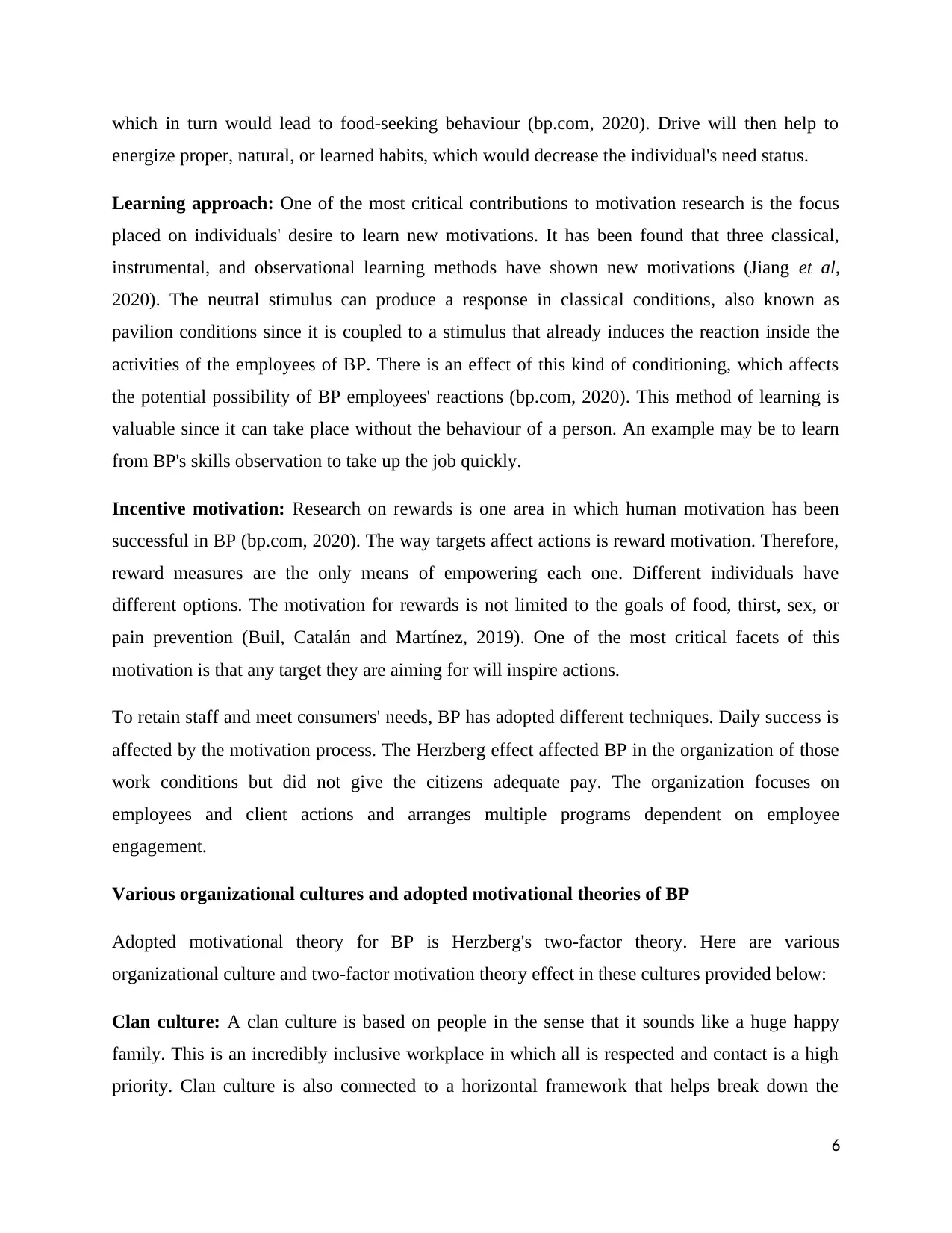
which in turn would lead to food-seeking behaviour (bp.com, 2020). Drive will then help to
energize proper, natural, or learned habits, which would decrease the individual's need status.
Learning approach: One of the most critical contributions to motivation research is the focus
placed on individuals' desire to learn new motivations. It has been found that three classical,
instrumental, and observational learning methods have shown new motivations (Jiang et al,
2020). The neutral stimulus can produce a response in classical conditions, also known as
pavilion conditions since it is coupled to a stimulus that already induces the reaction inside the
activities of the employees of BP. There is an effect of this kind of conditioning, which affects
the potential possibility of BP employees' reactions (bp.com, 2020). This method of learning is
valuable since it can take place without the behaviour of a person. An example may be to learn
from BP's skills observation to take up the job quickly.
Incentive motivation: Research on rewards is one area in which human motivation has been
successful in BP (bp.com, 2020). The way targets affect actions is reward motivation. Therefore,
reward measures are the only means of empowering each one. Different individuals have
different options. The motivation for rewards is not limited to the goals of food, thirst, sex, or
pain prevention (Buil, Catalán and Martínez, 2019). One of the most critical facets of this
motivation is that any target they are aiming for will inspire actions.
To retain staff and meet consumers' needs, BP has adopted different techniques. Daily success is
affected by the motivation process. The Herzberg effect affected BP in the organization of those
work conditions but did not give the citizens adequate pay. The organization focuses on
employees and client actions and arranges multiple programs dependent on employee
engagement.
Various organizational cultures and adopted motivational theories of BP
Adopted motivational theory for BP is Herzberg's two-factor theory. Here are various
organizational culture and two-factor motivation theory effect in these cultures provided below:
Clan culture: A clan culture is based on people in the sense that it sounds like a huge happy
family. This is an incredibly inclusive workplace in which all is respected and contact is a high
priority. Clan culture is also connected to a horizontal framework that helps break down the
6
energize proper, natural, or learned habits, which would decrease the individual's need status.
Learning approach: One of the most critical contributions to motivation research is the focus
placed on individuals' desire to learn new motivations. It has been found that three classical,
instrumental, and observational learning methods have shown new motivations (Jiang et al,
2020). The neutral stimulus can produce a response in classical conditions, also known as
pavilion conditions since it is coupled to a stimulus that already induces the reaction inside the
activities of the employees of BP. There is an effect of this kind of conditioning, which affects
the potential possibility of BP employees' reactions (bp.com, 2020). This method of learning is
valuable since it can take place without the behaviour of a person. An example may be to learn
from BP's skills observation to take up the job quickly.
Incentive motivation: Research on rewards is one area in which human motivation has been
successful in BP (bp.com, 2020). The way targets affect actions is reward motivation. Therefore,
reward measures are the only means of empowering each one. Different individuals have
different options. The motivation for rewards is not limited to the goals of food, thirst, sex, or
pain prevention (Buil, Catalán and Martínez, 2019). One of the most critical facets of this
motivation is that any target they are aiming for will inspire actions.
To retain staff and meet consumers' needs, BP has adopted different techniques. Daily success is
affected by the motivation process. The Herzberg effect affected BP in the organization of those
work conditions but did not give the citizens adequate pay. The organization focuses on
employees and client actions and arranges multiple programs dependent on employee
engagement.
Various organizational cultures and adopted motivational theories of BP
Adopted motivational theory for BP is Herzberg's two-factor theory. Here are various
organizational culture and two-factor motivation theory effect in these cultures provided below:
Clan culture: A clan culture is based on people in the sense that it sounds like a huge happy
family. This is an incredibly inclusive workplace in which all is respected and contact is a high
priority. Clan culture is also connected to a horizontal framework that helps break down the
6
⊘ This is a preview!⊘
Do you want full access?
Subscribe today to unlock all pages.

Trusted by 1+ million students worldwide
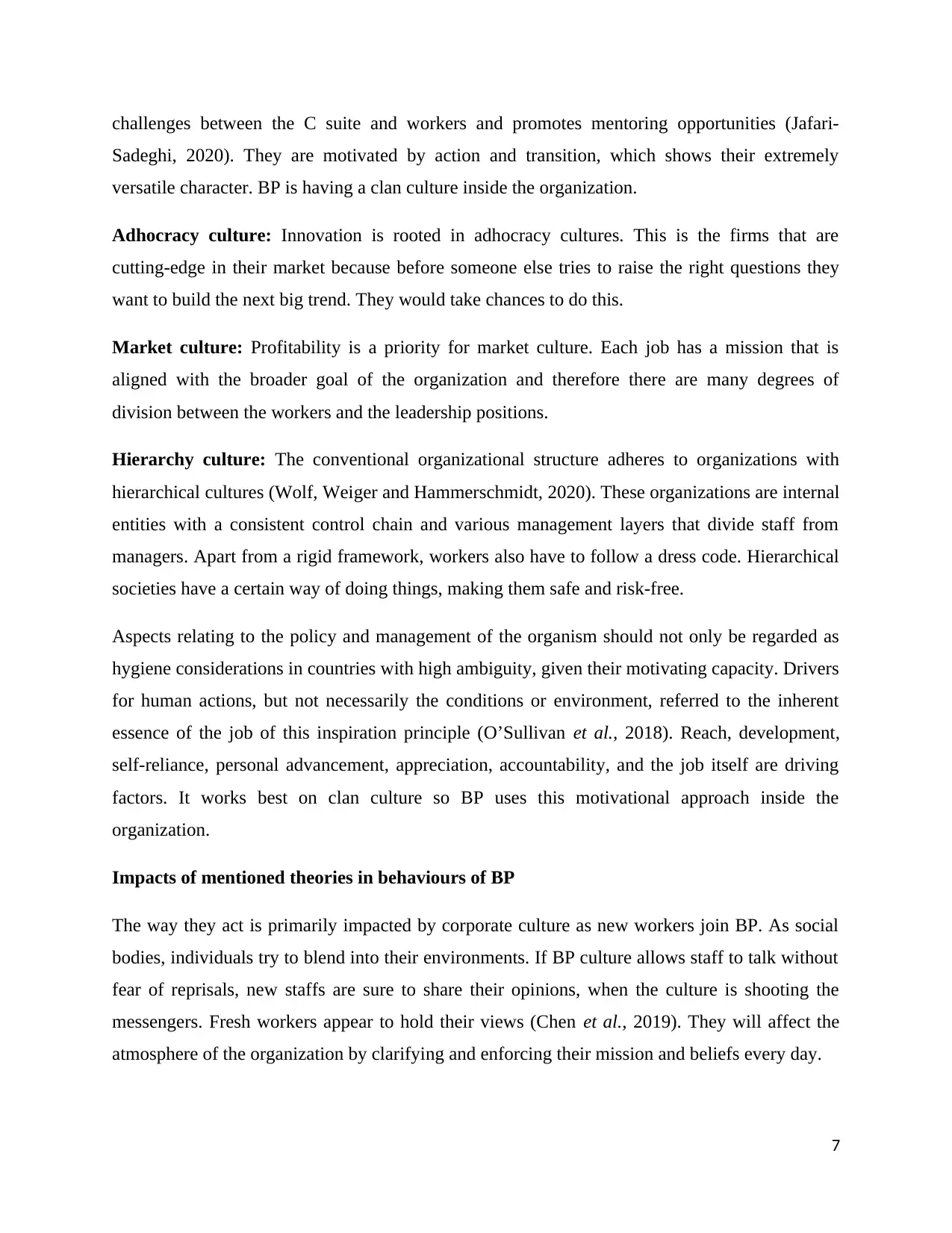
challenges between the C suite and workers and promotes mentoring opportunities (Jafari-
Sadeghi, 2020). They are motivated by action and transition, which shows their extremely
versatile character. BP is having a clan culture inside the organization.
Adhocracy culture: Innovation is rooted in adhocracy cultures. This is the firms that are
cutting-edge in their market because before someone else tries to raise the right questions they
want to build the next big trend. They would take chances to do this.
Market culture: Profitability is a priority for market culture. Each job has a mission that is
aligned with the broader goal of the organization and therefore there are many degrees of
division between the workers and the leadership positions.
Hierarchy culture: The conventional organizational structure adheres to organizations with
hierarchical cultures (Wolf, Weiger and Hammerschmidt, 2020). These organizations are internal
entities with a consistent control chain and various management layers that divide staff from
managers. Apart from a rigid framework, workers also have to follow a dress code. Hierarchical
societies have a certain way of doing things, making them safe and risk-free.
Aspects relating to the policy and management of the organism should not only be regarded as
hygiene considerations in countries with high ambiguity, given their motivating capacity. Drivers
for human actions, but not necessarily the conditions or environment, referred to the inherent
essence of the job of this inspiration principle (O’Sullivan et al., 2018). Reach, development,
self-reliance, personal advancement, appreciation, accountability, and the job itself are driving
factors. It works best on clan culture so BP uses this motivational approach inside the
organization.
Impacts of mentioned theories in behaviours of BP
The way they act is primarily impacted by corporate culture as new workers join BP. As social
bodies, individuals try to blend into their environments. If BP culture allows staff to talk without
fear of reprisals, new staffs are sure to share their opinions, when the culture is shooting the
messengers. Fresh workers appear to hold their views (Chen et al., 2019). They will affect the
atmosphere of the organization by clarifying and enforcing their mission and beliefs every day.
7
Sadeghi, 2020). They are motivated by action and transition, which shows their extremely
versatile character. BP is having a clan culture inside the organization.
Adhocracy culture: Innovation is rooted in adhocracy cultures. This is the firms that are
cutting-edge in their market because before someone else tries to raise the right questions they
want to build the next big trend. They would take chances to do this.
Market culture: Profitability is a priority for market culture. Each job has a mission that is
aligned with the broader goal of the organization and therefore there are many degrees of
division between the workers and the leadership positions.
Hierarchy culture: The conventional organizational structure adheres to organizations with
hierarchical cultures (Wolf, Weiger and Hammerschmidt, 2020). These organizations are internal
entities with a consistent control chain and various management layers that divide staff from
managers. Apart from a rigid framework, workers also have to follow a dress code. Hierarchical
societies have a certain way of doing things, making them safe and risk-free.
Aspects relating to the policy and management of the organism should not only be regarded as
hygiene considerations in countries with high ambiguity, given their motivating capacity. Drivers
for human actions, but not necessarily the conditions or environment, referred to the inherent
essence of the job of this inspiration principle (O’Sullivan et al., 2018). Reach, development,
self-reliance, personal advancement, appreciation, accountability, and the job itself are driving
factors. It works best on clan culture so BP uses this motivational approach inside the
organization.
Impacts of mentioned theories in behaviours of BP
The way they act is primarily impacted by corporate culture as new workers join BP. As social
bodies, individuals try to blend into their environments. If BP culture allows staff to talk without
fear of reprisals, new staffs are sure to share their opinions, when the culture is shooting the
messengers. Fresh workers appear to hold their views (Chen et al., 2019). They will affect the
atmosphere of the organization by clarifying and enforcing their mission and beliefs every day.
7
Paraphrase This Document
Need a fresh take? Get an instant paraphrase of this document with our AI Paraphraser
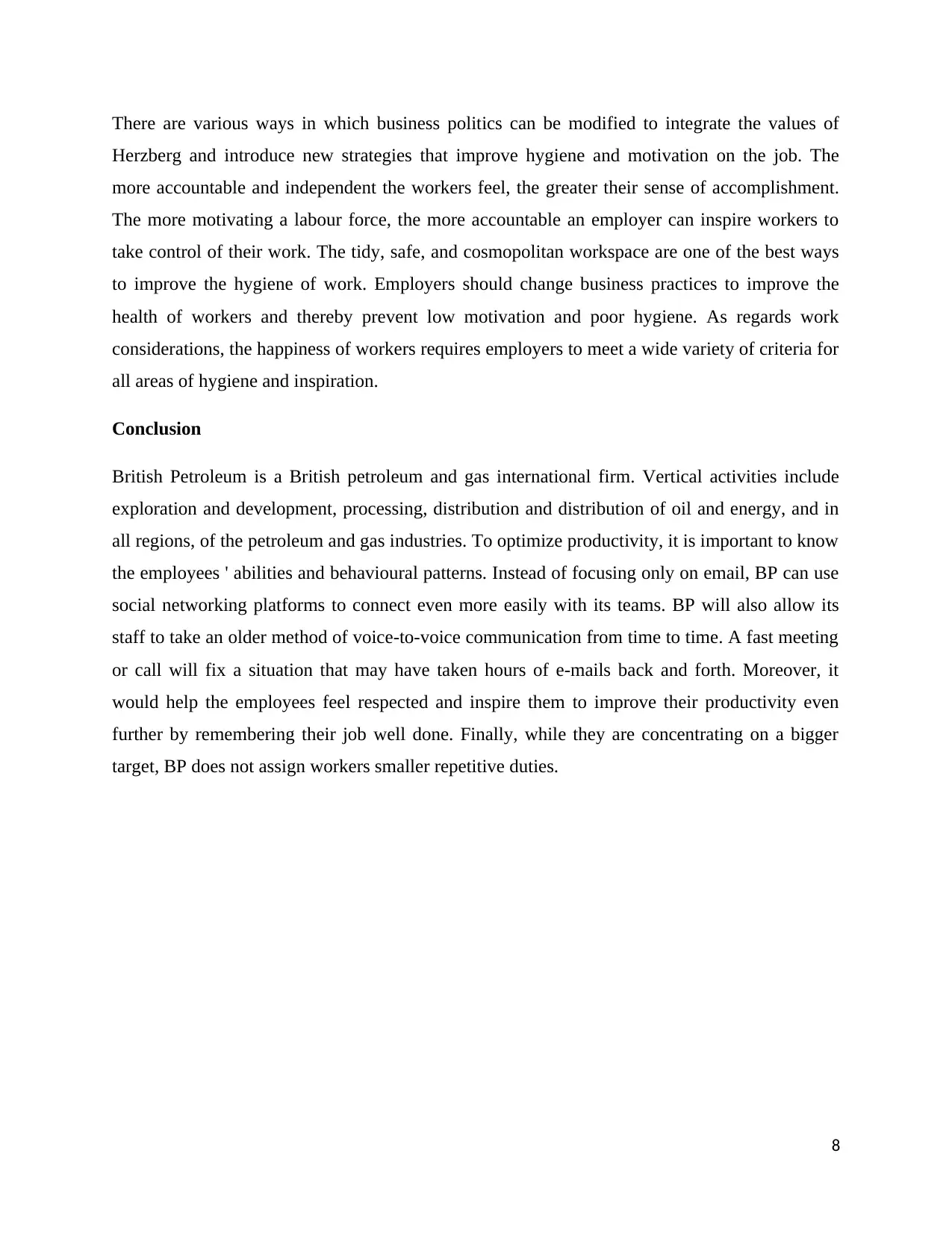
There are various ways in which business politics can be modified to integrate the values of
Herzberg and introduce new strategies that improve hygiene and motivation on the job. The
more accountable and independent the workers feel, the greater their sense of accomplishment.
The more motivating a labour force, the more accountable an employer can inspire workers to
take control of their work. The tidy, safe, and cosmopolitan workspace are one of the best ways
to improve the hygiene of work. Employers should change business practices to improve the
health of workers and thereby prevent low motivation and poor hygiene. As regards work
considerations, the happiness of workers requires employers to meet a wide variety of criteria for
all areas of hygiene and inspiration.
Conclusion
British Petroleum is a British petroleum and gas international firm. Vertical activities include
exploration and development, processing, distribution and distribution of oil and energy, and in
all regions, of the petroleum and gas industries. To optimize productivity, it is important to know
the employees ' abilities and behavioural patterns. Instead of focusing only on email, BP can use
social networking platforms to connect even more easily with its teams. BP will also allow its
staff to take an older method of voice-to-voice communication from time to time. A fast meeting
or call will fix a situation that may have taken hours of e-mails back and forth. Moreover, it
would help the employees feel respected and inspire them to improve their productivity even
further by remembering their job well done. Finally, while they are concentrating on a bigger
target, BP does not assign workers smaller repetitive duties.
8
Herzberg and introduce new strategies that improve hygiene and motivation on the job. The
more accountable and independent the workers feel, the greater their sense of accomplishment.
The more motivating a labour force, the more accountable an employer can inspire workers to
take control of their work. The tidy, safe, and cosmopolitan workspace are one of the best ways
to improve the hygiene of work. Employers should change business practices to improve the
health of workers and thereby prevent low motivation and poor hygiene. As regards work
considerations, the happiness of workers requires employers to meet a wide variety of criteria for
all areas of hygiene and inspiration.
Conclusion
British Petroleum is a British petroleum and gas international firm. Vertical activities include
exploration and development, processing, distribution and distribution of oil and energy, and in
all regions, of the petroleum and gas industries. To optimize productivity, it is important to know
the employees ' abilities and behavioural patterns. Instead of focusing only on email, BP can use
social networking platforms to connect even more easily with its teams. BP will also allow its
staff to take an older method of voice-to-voice communication from time to time. A fast meeting
or call will fix a situation that may have taken hours of e-mails back and forth. Moreover, it
would help the employees feel respected and inspire them to improve their productivity even
further by remembering their job well done. Finally, while they are concentrating on a bigger
target, BP does not assign workers smaller repetitive duties.
8
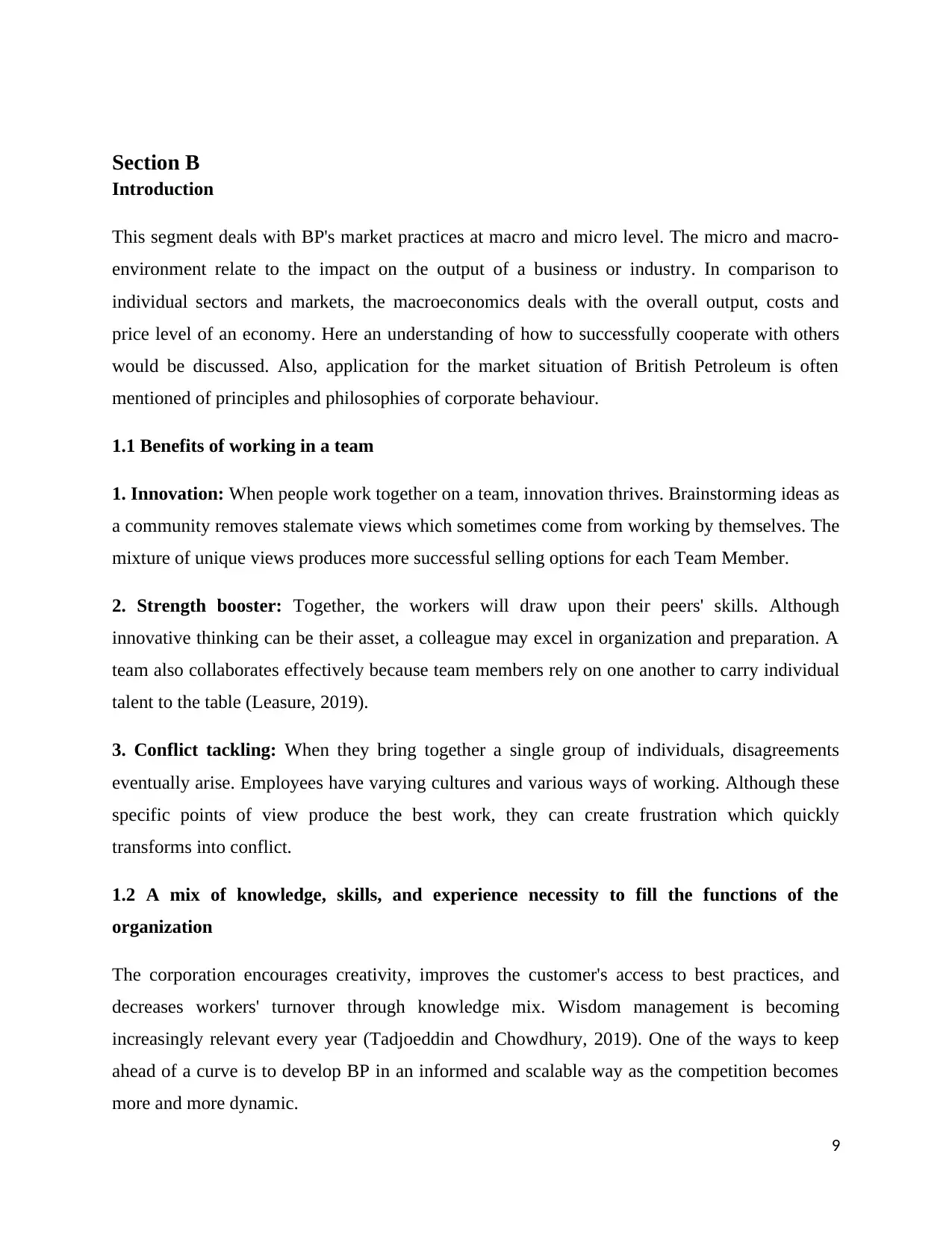
Section B
Introduction
This segment deals with BP's market practices at macro and micro level. The micro and macro-
environment relate to the impact on the output of a business or industry. In comparison to
individual sectors and markets, the macroeconomics deals with the overall output, costs and
price level of an economy. Here an understanding of how to successfully cooperate with others
would be discussed. Also, application for the market situation of British Petroleum is often
mentioned of principles and philosophies of corporate behaviour.
1.1 Benefits of working in a team
1. Innovation: When people work together on a team, innovation thrives. Brainstorming ideas as
a community removes stalemate views which sometimes come from working by themselves. The
mixture of unique views produces more successful selling options for each Team Member.
2. Strength booster: Together, the workers will draw upon their peers' skills. Although
innovative thinking can be their asset, a colleague may excel in organization and preparation. A
team also collaborates effectively because team members rely on one another to carry individual
talent to the table (Leasure, 2019).
3. Conflict tackling: When they bring together a single group of individuals, disagreements
eventually arise. Employees have varying cultures and various ways of working. Although these
specific points of view produce the best work, they can create frustration which quickly
transforms into conflict.
1.2 A mix of knowledge, skills, and experience necessity to fill the functions of the
organization
The corporation encourages creativity, improves the customer's access to best practices, and
decreases workers' turnover through knowledge mix. Wisdom management is becoming
increasingly relevant every year (Tadjoeddin and Chowdhury, 2019). One of the ways to keep
ahead of a curve is to develop BP in an informed and scalable way as the competition becomes
more and more dynamic.
9
Introduction
This segment deals with BP's market practices at macro and micro level. The micro and macro-
environment relate to the impact on the output of a business or industry. In comparison to
individual sectors and markets, the macroeconomics deals with the overall output, costs and
price level of an economy. Here an understanding of how to successfully cooperate with others
would be discussed. Also, application for the market situation of British Petroleum is often
mentioned of principles and philosophies of corporate behaviour.
1.1 Benefits of working in a team
1. Innovation: When people work together on a team, innovation thrives. Brainstorming ideas as
a community removes stalemate views which sometimes come from working by themselves. The
mixture of unique views produces more successful selling options for each Team Member.
2. Strength booster: Together, the workers will draw upon their peers' skills. Although
innovative thinking can be their asset, a colleague may excel in organization and preparation. A
team also collaborates effectively because team members rely on one another to carry individual
talent to the table (Leasure, 2019).
3. Conflict tackling: When they bring together a single group of individuals, disagreements
eventually arise. Employees have varying cultures and various ways of working. Although these
specific points of view produce the best work, they can create frustration which quickly
transforms into conflict.
1.2 A mix of knowledge, skills, and experience necessity to fill the functions of the
organization
The corporation encourages creativity, improves the customer's access to best practices, and
decreases workers' turnover through knowledge mix. Wisdom management is becoming
increasingly relevant every year (Tadjoeddin and Chowdhury, 2019). One of the ways to keep
ahead of a curve is to develop BP in an informed and scalable way as the competition becomes
more and more dynamic.
9
⊘ This is a preview!⊘
Do you want full access?
Subscribe today to unlock all pages.

Trusted by 1+ million students worldwide
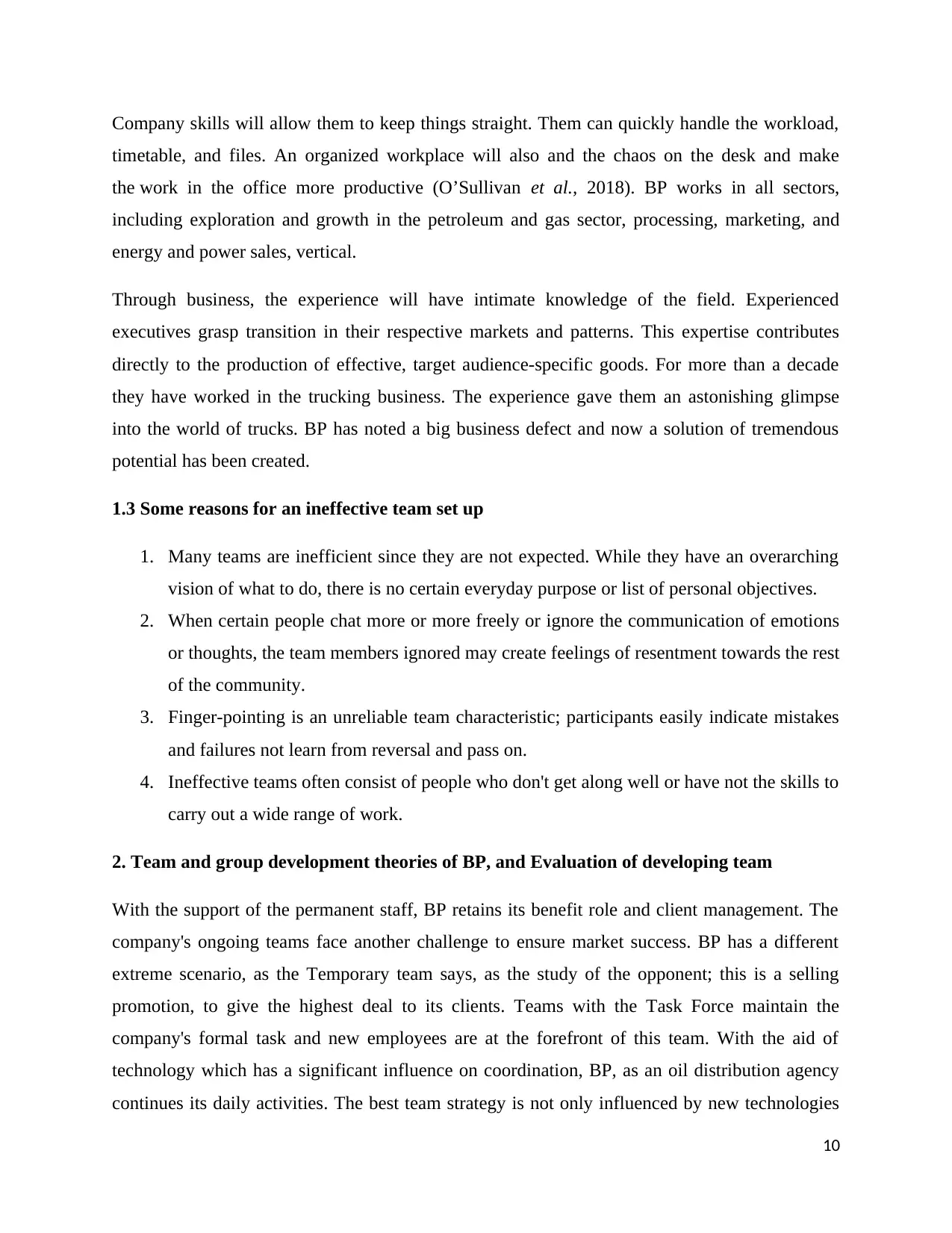
Company skills will allow them to keep things straight. Them can quickly handle the workload,
timetable, and files. An organized workplace will also and the chaos on the desk and make
the work in the office more productive (O’Sullivan et al., 2018). BP works in all sectors,
including exploration and growth in the petroleum and gas sector, processing, marketing, and
energy and power sales, vertical.
Through business, the experience will have intimate knowledge of the field. Experienced
executives grasp transition in their respective markets and patterns. This expertise contributes
directly to the production of effective, target audience-specific goods. For more than a decade
they have worked in the trucking business. The experience gave them an astonishing glimpse
into the world of trucks. BP has noted a big business defect and now a solution of tremendous
potential has been created.
1.3 Some reasons for an ineffective team set up
1. Many teams are inefficient since they are not expected. While they have an overarching
vision of what to do, there is no certain everyday purpose or list of personal objectives.
2. When certain people chat more or more freely or ignore the communication of emotions
or thoughts, the team members ignored may create feelings of resentment towards the rest
of the community.
3. Finger-pointing is an unreliable team characteristic; participants easily indicate mistakes
and failures not learn from reversal and pass on.
4. Ineffective teams often consist of people who don't get along well or have not the skills to
carry out a wide range of work.
2. Team and group development theories of BP, and Evaluation of developing team
With the support of the permanent staff, BP retains its benefit role and client management. The
company's ongoing teams face another challenge to ensure market success. BP has a different
extreme scenario, as the Temporary team says, as the study of the opponent; this is a selling
promotion, to give the highest deal to its clients. Teams with the Task Force maintain the
company's formal task and new employees are at the forefront of this team. With the aid of
technology which has a significant influence on coordination, BP, as an oil distribution agency
continues its daily activities. The best team strategy is not only influenced by new technologies
10
timetable, and files. An organized workplace will also and the chaos on the desk and make
the work in the office more productive (O’Sullivan et al., 2018). BP works in all sectors,
including exploration and growth in the petroleum and gas sector, processing, marketing, and
energy and power sales, vertical.
Through business, the experience will have intimate knowledge of the field. Experienced
executives grasp transition in their respective markets and patterns. This expertise contributes
directly to the production of effective, target audience-specific goods. For more than a decade
they have worked in the trucking business. The experience gave them an astonishing glimpse
into the world of trucks. BP has noted a big business defect and now a solution of tremendous
potential has been created.
1.3 Some reasons for an ineffective team set up
1. Many teams are inefficient since they are not expected. While they have an overarching
vision of what to do, there is no certain everyday purpose or list of personal objectives.
2. When certain people chat more or more freely or ignore the communication of emotions
or thoughts, the team members ignored may create feelings of resentment towards the rest
of the community.
3. Finger-pointing is an unreliable team characteristic; participants easily indicate mistakes
and failures not learn from reversal and pass on.
4. Ineffective teams often consist of people who don't get along well or have not the skills to
carry out a wide range of work.
2. Team and group development theories of BP, and Evaluation of developing team
With the support of the permanent staff, BP retains its benefit role and client management. The
company's ongoing teams face another challenge to ensure market success. BP has a different
extreme scenario, as the Temporary team says, as the study of the opponent; this is a selling
promotion, to give the highest deal to its clients. Teams with the Task Force maintain the
company's formal task and new employees are at the forefront of this team. With the aid of
technology which has a significant influence on coordination, BP, as an oil distribution agency
continues its daily activities. The best team strategy is not only influenced by new technologies
10
Paraphrase This Document
Need a fresh take? Get an instant paraphrase of this document with our AI Paraphraser
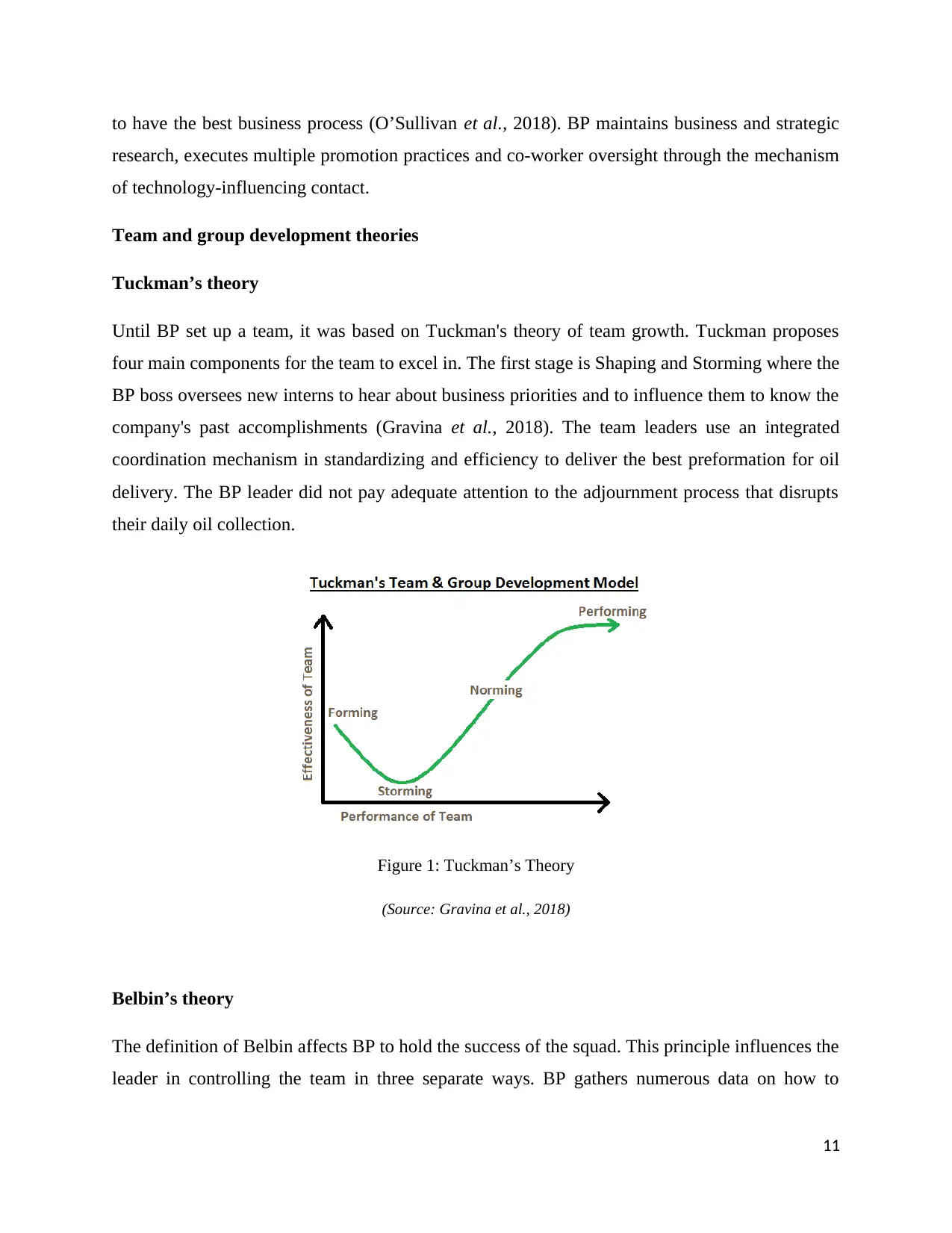
to have the best business process (O’Sullivan et al., 2018). BP maintains business and strategic
research, executes multiple promotion practices and co-worker oversight through the mechanism
of technology-influencing contact.
Team and group development theories
Tuckman’s theory
Until BP set up a team, it was based on Tuckman's theory of team growth. Tuckman proposes
four main components for the team to excel in. The first stage is Shaping and Storming where the
BP boss oversees new interns to hear about business priorities and to influence them to know the
company's past accomplishments (Gravina et al., 2018). The team leaders use an integrated
coordination mechanism in standardizing and efficiency to deliver the best preformation for oil
delivery. The BP leader did not pay adequate attention to the adjournment process that disrupts
their daily oil collection.
Figure 1: Tuckman’s Theory
(Source: Gravina et al., 2018)
Belbin’s theory
The definition of Belbin affects BP to hold the success of the squad. This principle influences the
leader in controlling the team in three separate ways. BP gathers numerous data on how to
11
research, executes multiple promotion practices and co-worker oversight through the mechanism
of technology-influencing contact.
Team and group development theories
Tuckman’s theory
Until BP set up a team, it was based on Tuckman's theory of team growth. Tuckman proposes
four main components for the team to excel in. The first stage is Shaping and Storming where the
BP boss oversees new interns to hear about business priorities and to influence them to know the
company's past accomplishments (Gravina et al., 2018). The team leaders use an integrated
coordination mechanism in standardizing and efficiency to deliver the best preformation for oil
delivery. The BP leader did not pay adequate attention to the adjournment process that disrupts
their daily oil collection.
Figure 1: Tuckman’s Theory
(Source: Gravina et al., 2018)
Belbin’s theory
The definition of Belbin affects BP to hold the success of the squad. This principle influences the
leader in controlling the team in three separate ways. BP gathers numerous data on how to
11
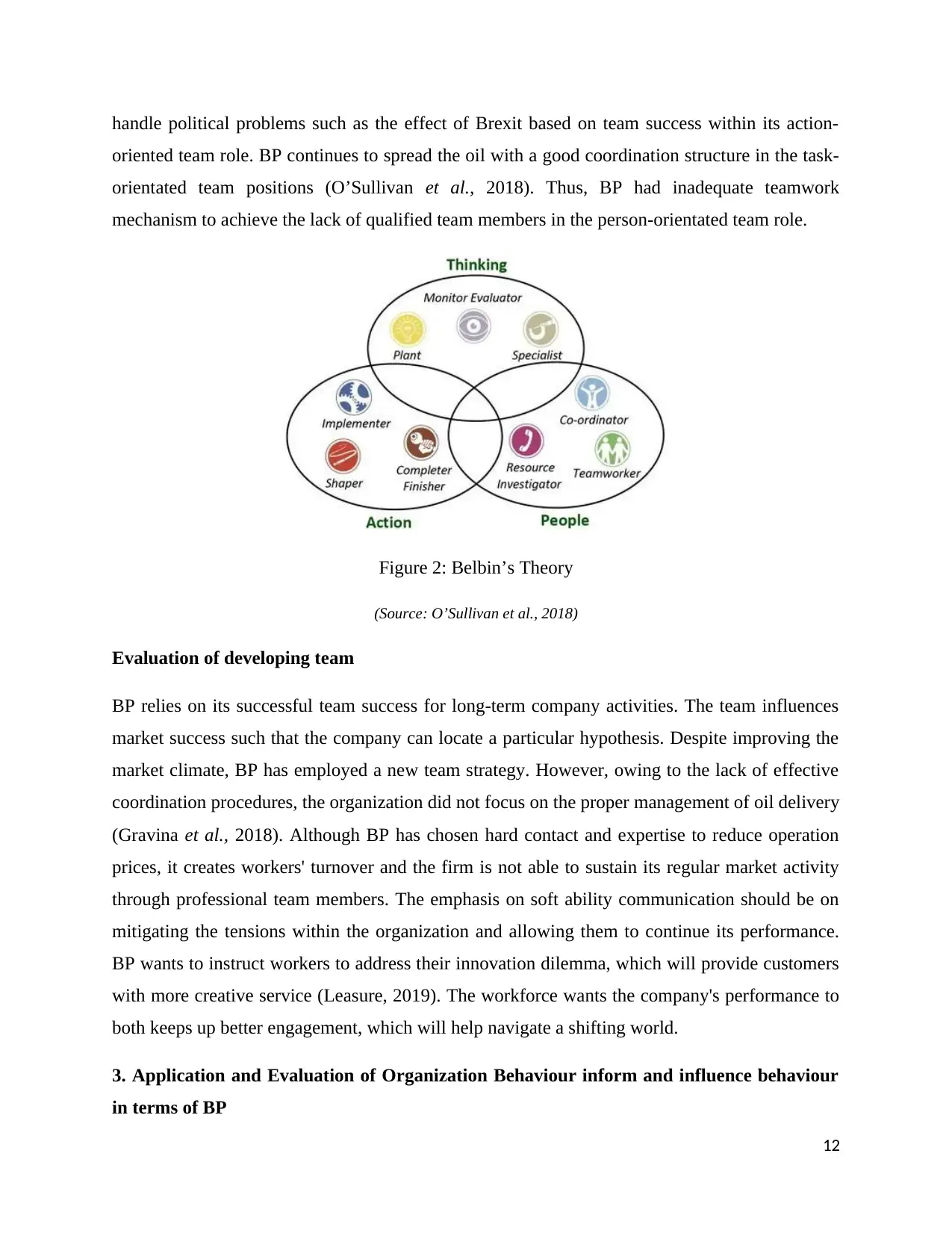
handle political problems such as the effect of Brexit based on team success within its action-
oriented team role. BP continues to spread the oil with a good coordination structure in the task-
orientated team positions (O’Sullivan et al., 2018). Thus, BP had inadequate teamwork
mechanism to achieve the lack of qualified team members in the person-orientated team role.
Figure 2: Belbin’s Theory
(Source: O’Sullivan et al., 2018)
Evaluation of developing team
BP relies on its successful team success for long-term company activities. The team influences
market success such that the company can locate a particular hypothesis. Despite improving the
market climate, BP has employed a new team strategy. However, owing to the lack of effective
coordination procedures, the organization did not focus on the proper management of oil delivery
(Gravina et al., 2018). Although BP has chosen hard contact and expertise to reduce operation
prices, it creates workers' turnover and the firm is not able to sustain its regular market activity
through professional team members. The emphasis on soft ability communication should be on
mitigating the tensions within the organization and allowing them to continue its performance.
BP wants to instruct workers to address their innovation dilemma, which will provide customers
with more creative service (Leasure, 2019). The workforce wants the company's performance to
both keeps up better engagement, which will help navigate a shifting world.
3. Application and Evaluation of Organization Behaviour inform and influence behaviour
in terms of BP
12
oriented team role. BP continues to spread the oil with a good coordination structure in the task-
orientated team positions (O’Sullivan et al., 2018). Thus, BP had inadequate teamwork
mechanism to achieve the lack of qualified team members in the person-orientated team role.
Figure 2: Belbin’s Theory
(Source: O’Sullivan et al., 2018)
Evaluation of developing team
BP relies on its successful team success for long-term company activities. The team influences
market success such that the company can locate a particular hypothesis. Despite improving the
market climate, BP has employed a new team strategy. However, owing to the lack of effective
coordination procedures, the organization did not focus on the proper management of oil delivery
(Gravina et al., 2018). Although BP has chosen hard contact and expertise to reduce operation
prices, it creates workers' turnover and the firm is not able to sustain its regular market activity
through professional team members. The emphasis on soft ability communication should be on
mitigating the tensions within the organization and allowing them to continue its performance.
BP wants to instruct workers to address their innovation dilemma, which will provide customers
with more creative service (Leasure, 2019). The workforce wants the company's performance to
both keeps up better engagement, which will help navigate a shifting world.
3. Application and Evaluation of Organization Behaviour inform and influence behaviour
in terms of BP
12
⊘ This is a preview!⊘
Do you want full access?
Subscribe today to unlock all pages.

Trusted by 1+ million students worldwide
1 out of 17
Related Documents
Your All-in-One AI-Powered Toolkit for Academic Success.
+13062052269
info@desklib.com
Available 24*7 on WhatsApp / Email
![[object Object]](/_next/static/media/star-bottom.7253800d.svg)
Unlock your academic potential
Copyright © 2020–2025 A2Z Services. All Rights Reserved. Developed and managed by ZUCOL.



